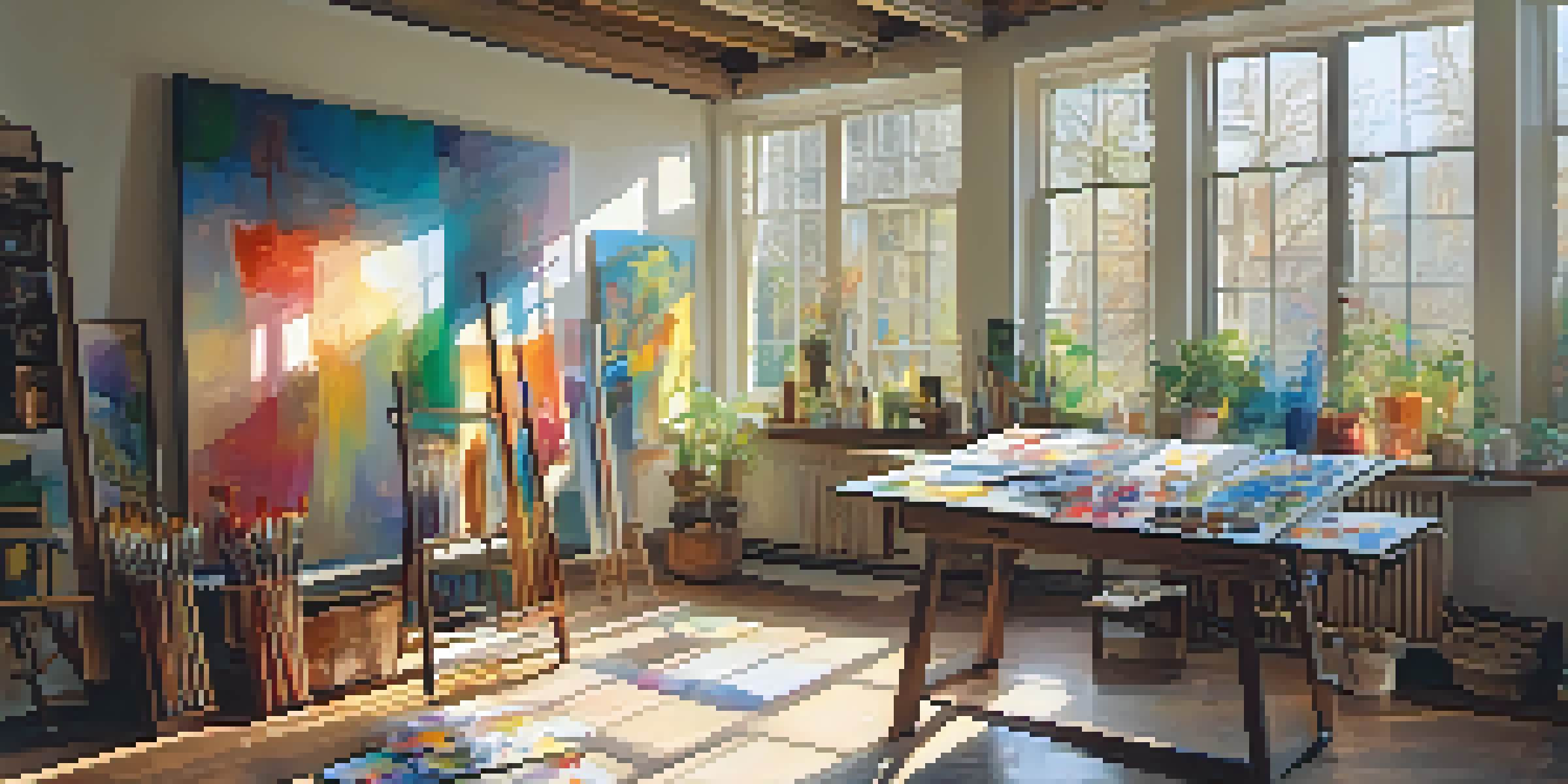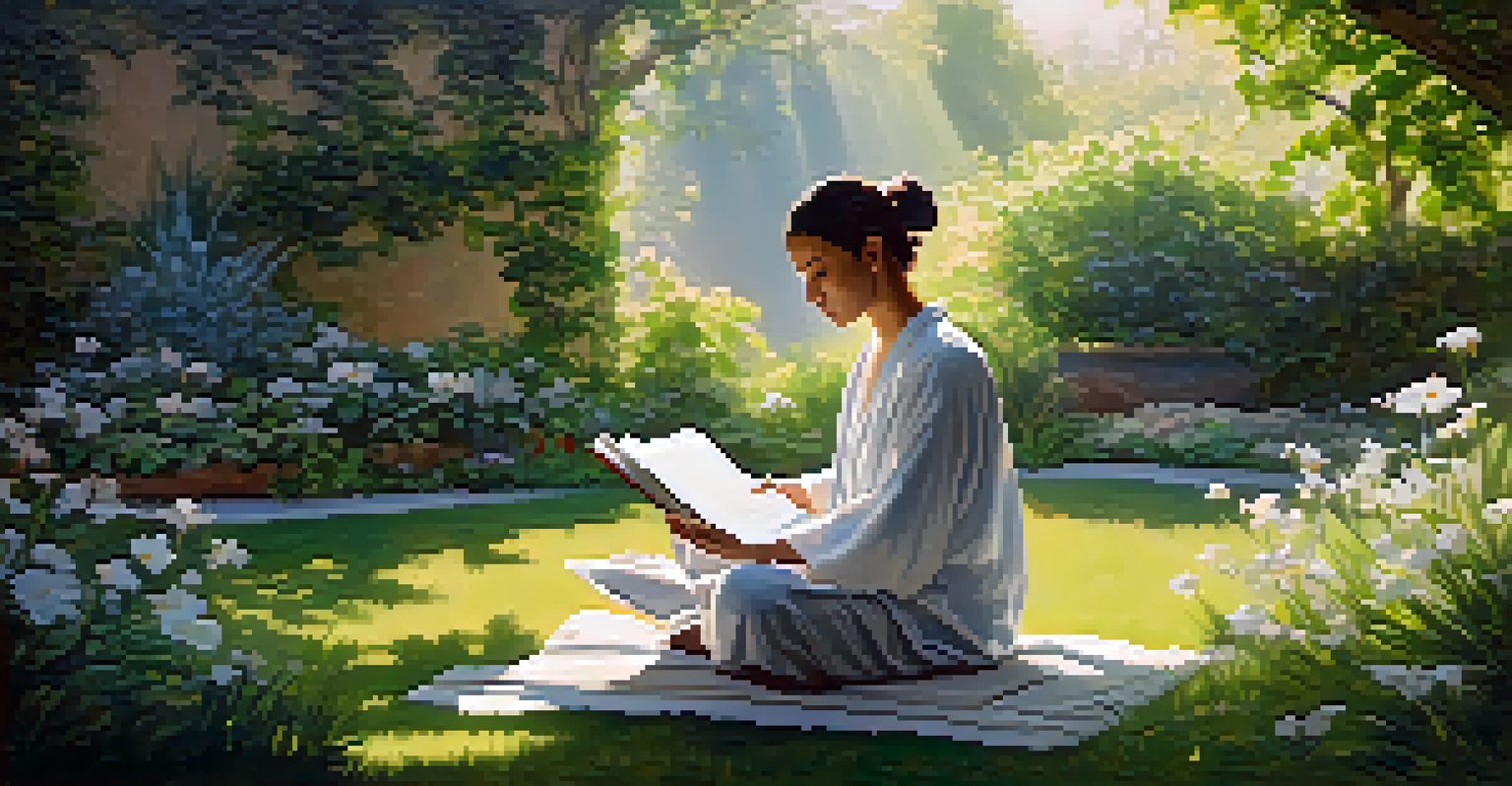Divine Inspiration: The Artist's Role in Spirituality

Understanding Divine Inspiration in Art
Divine inspiration has long been a source of creativity for artists, often seen as a mystical force that drives them to create. This concept suggests that artists tap into a higher realm of thought or spiritual essence, allowing them to express ideas that resonate deeply with humanity. Much like a musician feels the rhythm of the universe, artists often describe moments when their work flows effortlessly, as if guided by an unseen hand.
Art is the most beautiful of all lies.
For many, this connection to divine inspiration transforms the act of creating art into a spiritual practice. It invites artists to explore themes of existence, purpose, and the divine, making their work a reflection of their inner journey. This blend of creativity and spirituality not only enriches the artist's experience but also invites audiences to engage with their art on a deeper, more meaningful level.
Ultimately, the notion of divine inspiration encourages artists to embrace vulnerability, allowing their personal beliefs and feelings to shine through in their work. This openness fosters a connection with viewers who may find solace or inspiration in the art, bridging the gap between the artist's spiritual experience and the audience's individual interpretations.
The Role of the Artist as a Spiritual Channel
Artists are often viewed as conduits for spiritual expression, channeling emotions and experiences that resonate with the human condition. When an artist creates, they may feel a deep sense of responsibility to convey messages that can uplift, challenge, or inspire others. This role is akin to that of a spiritual guide, helping others navigate their own paths through the lens of art.

Through their creations, artists can explore complex themes such as love, loss, and transcendence. These themes not only reflect their personal experiences but also resonate with universal truths that many people grapple with. By embodying these concepts in their work, artists invite their audience to reflect on their own spiritual journeys, creating a shared experience that can be both profound and healing.
Divine Inspiration Fuels Creativity
Artists often experience divine inspiration as a mystical force that guides their creative process, allowing them to express profound ideas.
Moreover, this role as a spiritual channel often leads artists to explore different mediums and styles, experimenting with various techniques to best express their vision. Whether through painting, music, or writing, each medium serves as a unique vessel for their spiritual insights, allowing them to communicate their messages in diverse and impactful ways.
Art as a Medium for Spiritual Exploration
Art has the remarkable ability to serve as a medium for exploring spiritual themes. From religious iconography to abstract expressions of emotion, artists use their craft to delve into the mysteries of existence. This exploration invites both the creator and the viewer to reflect on their beliefs, values, and experiences in a safe and creative space.
Every artist dips his brush in his own soul, and paints his own nature into his pictures.
Consider the way a piece of music can evoke feelings of nostalgia or a painting can inspire awe; these emotional responses can prompt deeper introspection about life's greater meanings. When artists channel their spiritual inquiries into their work, they create pieces that resonate on multiple levels, often sparking conversations about faith, purpose, and the human experience.
Furthermore, the act of creating art itself can be a spiritual practice, offering artists a chance to meditate on their thoughts and feelings. This process can lead to moments of clarity, allowing them to navigate their own spiritual paths while simultaneously inviting others to join them on this journey through their art.
Historical Perspectives on Art and Spirituality
Throughout history, art and spirituality have been intertwined across cultures and religions. From the intricate murals of ancient temples to the grand cathedrals adorned with stained glass, artists have long been commissioned to create works that reflect and elevate spiritual beliefs. These historical examples highlight the profound impact that art can have on communal and individual spirituality.
Notably, many renowned artists, such as Michelangelo and Van Gogh, found their inspiration in their spiritual beliefs, showcasing how personal faith can fuel creativity. Their works often embody a quest for understanding the divine, transforming their struggles and revelations into masterpieces that continue to inspire generations. This historical context enriches our understanding of the artist's role in exploring the divine.
Art as Spiritual Healing
Engaging with art serves as a therapeutic outlet for both creators and audiences, facilitating emotional exploration and personal growth.
Additionally, the evolution of art movements, such as Romanticism and Surrealism, demonstrates a growing interest in the inner self and the spiritual realm. By examining the interplay between these movements and spirituality, we can appreciate how artists have continuously sought to bridge the gap between the material and the metaphysical through their work.
The Healing Power of Art in Spirituality
Art possesses a unique healing power, serving as a therapeutic outlet for both artists and audiences. Engaging with art allows individuals to explore their emotions, confront their fears, and express their innermost thoughts in a constructive manner. This therapeutic aspect can be particularly beneficial for those navigating their own spiritual journeys, providing a means of processing experiences and emotions.
For artists, creating art can be a form of self-care, allowing them to reconnect with their inner selves and find clarity amidst chaos. The act of creation often becomes a meditative practice, grounding them in the present moment while facilitating deep reflection. This process not only nurtures their spirit but also enhances their ability to convey meaningful messages through their work.
Moreover, audiences often find solace in art, as it serves as a mirror reflecting their own struggles and triumphs. By engaging with art that resonates with their experiences, individuals can experience catharsis, leading to personal growth and healing. This reciprocal relationship emphasizes the importance of art in spiritual well-being, making it a powerful tool for transformation.
The Intersection of Art and Religion
The intersection of art and religion has produced some of the most profound works in history, as artists strive to capture the essence of the divine. This relationship is often characterized by the desire to express faith visually, whether through religious paintings, sculptures, or even architecture. These artistic endeavors not only serve to glorify the divine but also to inspire faith and devotion in others.
Religious art often invites interpretation, encouraging viewers to engage with the spiritual narrative presented before them. Through symbolism and imagery, artists convey complex theological concepts, making them accessible to a broader audience. This ability to translate intricate spiritual ideas into visual forms highlights the artist's role as an interpreter of divine truths.
Art Reflects Spiritual Journeys
Through their work, artists explore their spiritual journeys, inviting viewers to reflect on their own beliefs and experiences.
However, the relationship between art and religion is not without tension. Artists may grapple with the expectations of their faith communities, balancing personal expression with doctrinal adherence. This dynamic can lead to innovative and thought-provoking works that challenge conventional interpretations, ultimately enriching the dialogue between art and spirituality.
Embracing the Artist's Spiritual Journey
Embracing the artist's spiritual journey involves recognizing the interconnectedness of creativity and spirituality in their work. Artists often navigate both external expectations and internal desires, seeking to find harmony between their personal beliefs and their artistic expression. This journey can be filled with challenges, triumphs, and moments of profound clarity that shape their identity as creators.
As artists explore their spirituality, they may find inspiration in diverse sources, from nature to literature to personal experiences. This eclectic approach enriches their artistic practice, allowing them to draw on a wide range of influences while remaining true to their own voice. As they delve deeper into their spiritual quests, artists can create works that resonate with authenticity and sincerity.

Ultimately, embracing this journey invites artists to celebrate their unique perspectives and experiences, fostering a sense of community among those who share similar paths. By openly sharing their spiritual explorations through their art, they encourage others to embark on their own journeys, creating a ripple effect that can inspire and uplift not only individuals but entire communities.